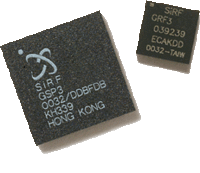
UPDATE: Here’s my 2010 take on SiRFstar III, which is rarely available these days.
There are a lot of hot new GPS receivers that use the SiRFstar III chipset, but unless you’re a heavy-duty GPS aficionado, you may be wondering, what the heck is this thing and what is the big deal? Simply put, it is a GPS receiver chipset. This is the little piece of silicon responsible for receiving GPS signals and passing the coordinate information along to a miniature computer in your GPS unit.
Why is it a big deal? Fast acquisition times and processing power. This translates into less likelihood of lost signals under canopy and in urban (or natural) canyons. In canyon-like environments, your GPS receives signals directly from satellites whenever it can, but it also receives reflected signals, bouncing off hard surfaces (multipath reflection). Your GPS determines your
position by calculating how long it takes the satellite signal to reach your receiver, so reflected signals are a source of error. The SiRFstar III chipset has the processing power to do a lot of "what if’s" with these reflected signals. This processing power also means that the chipset can consider weak signals that were ignored by previous chipsets. The SiRFstar III also has faster acquisition times, making for a faster time to first fix (TTFF), and a quicker reacquisition if the signal is lost.
All of this translates into amazing reception, under canopy, in urban centers and even indoors. And that is why the new Garmin units with this chipset are so hot.

Is there a GPS unit that works well in a car but can be carried when walking or biking to calculate distance, etc. and does not have a “hand held” size screen – touch screen would be great. Any suggestions?
At this point, there is really nothing I can recommend. The Magellan Crossover units were disappointing and Garmin nuvis don’t work that great on foot. Magellan is coming out with a handheld with a touchscreen next month, but we’ll have to wait and see how it performs, especially as an auto navigation device. You can read more about it here…
http://gpstracklog.com/2007/08/more-on-the-mag.html
Did I read that Garmin are now putting the SiRFstarIII chipset in the basic Nuvi’s? like the 200’s??
All the nuvis include a high-sensitivity chipset, but not necessarily the SiRFstar III. People have not been able to really tell much difference between the SiRF III and these newer high sensitivity chipsets.
Looking for a GPS-type chip?? to put into my husband’s shoes when he goes for a hike. He is a 58-yr old Alzheimer’s patient. I’ve heard of soething similar used for marathon runners in a military-based race in DC
The marathoners use RFID chips, and they only report the runners position when they pass within a few feet of a check station.
Two other options, but both rely on availability of a cellular signal:
1. GPS shoes. Google it.
2. Your cell phone provider probably offers a tracking plan. This is likely to be the best option, though there will be a monthly fee.
My old GPS receiver with PL-2303 chipset has no driver available for Vista, so I need a new receiver. But I can’t find anything that specifically says if the SiRF star III is compatible with Vista?
You don’t need to worry about chipset compatibility, just be sure the receiver (the GPS unit you purchase) is compatible.